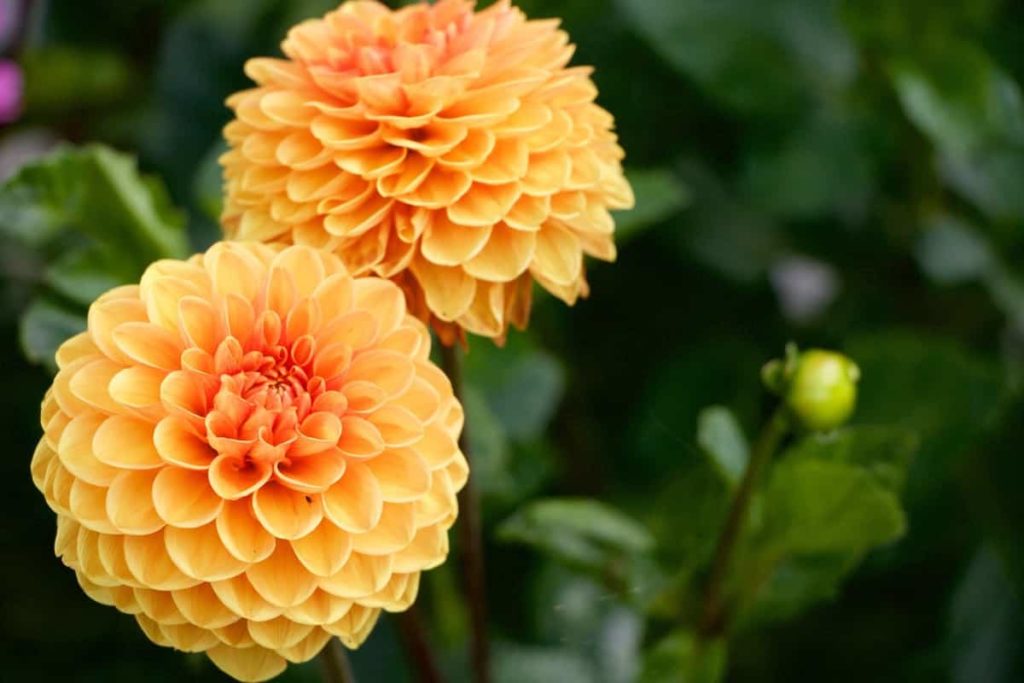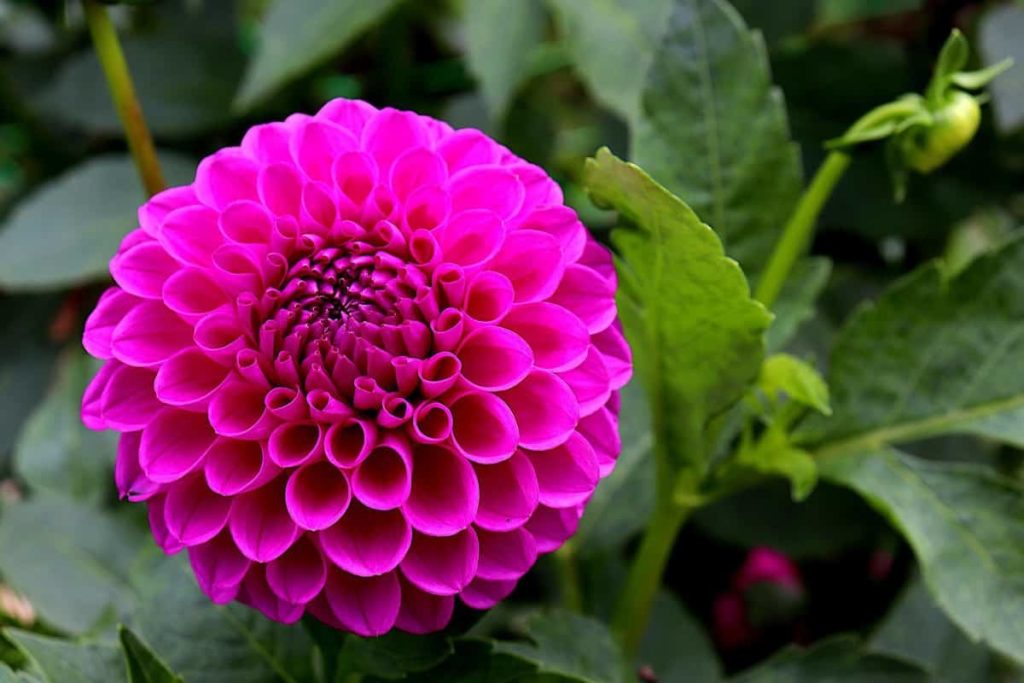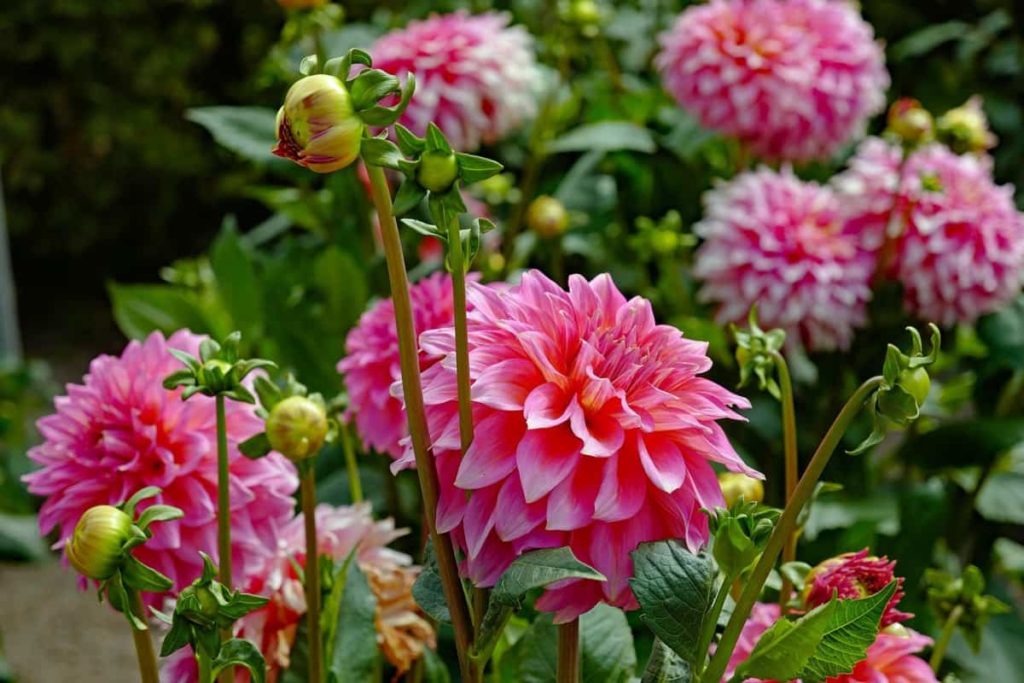Around the world, Dahlia is admired for its symbolic value, beneficial features, and attractive geometric flowers in a wide range of colors. But before these flowers appear, the tubers start in the soil, and correcting that soil type is the key to success. Let’s check out How to prepare the soil for Dahlia plants below.

Dahlia tubers are prone to rot in the wrong soil type. They need loose, nutritious, and well-draining soil on the sandier side to thrive. Avoid clay soils that hold too much moisture and prevent oxygen from reaching the roots. Dahlias are tall plants that need a lot of help to prevent their long stems from falling into the wind and rain, and a combination of healthy soil and stakes is very important for this process.
Different soils persist at different moisture levels; some drain freely while trapping other particles and remain moist for a long time. The soil type also determines the level of oxygen traveling through the soil and roots. That is why it is essential to compete with the needs of your plants in the right kind. Dahlia grows from a tuber which stores nutrients in the dormant season and protects the plant under the soil to allow it to pop up again next year.
It is very sensitive to rot, especially in the early stages of development before the roots are established. Because of this sensitivity, the best soil for most species of Dahlia is one that is light and well-drained. It should be completely free from any soil components that can maintain moisture and prevent oxygen from flowing through the soil. Beyond that need, they don’t make a huge fuss and will be happy in almost any soil. Dahlia usually thrives almost anywhere with adequate additional nutrients and maintenance.
How to prepare the soil for Dahlia plants
Soil pH for Dahlia
Dahlias are not very special in soil type but usually grow best when the pH is slightly acidic. Dahlias grow best in soil pH 6.5, but they should grow well in soil with a pH between 6 and just below 7. The soil test will help you better understand your pH and whether you need to make any modifications. If your soil is too acidic or alkaline, there are amendments that you can add that will improve your conditions in Dahlia. These amendments are done better before planting to ensure that no other modifications need to be made.
In case you missed it: Growth Stages of Flowering Plants: Rose, Marigold, Hibiscus, Dahlia, Gerbera Daisy, and Jasmine

Dahlia doesn’t like to worry once established. If your soil has above 7 pH, adding sulfur will decrease the pH faster. You can also use compost. This will gradually reduce soil pH over time while improving its quality versus sulfur which does not contribute to overall soil health. For soil with pH below 6, add lime over the soil, gently mix it, and water. Make sure you increase slowly to avoid overdoing it and raising your pH too much. Start small, test the soil, and adjust again if needed.
Preparation of soil for growing Dahlia on grounds
Add a 4-inch layer of compost to your planting beds, then work with a pitchfork to mix compost and native soil. It will take the nutrition back to your soil depleted from the previous year’s garden. Compost improves soil by adding organic matter to soften the soil. Compost allows the soil to be extracted better, adds oxygen to the soil by improving drainage, and attracts beneficial insects, worms, and microorganisms to your soil.
The benefits of compost are endless, but not too much is a good thing either. Your plants don’t like to grow in straight compost and need micronutrients from your native soil. Clay soil will become looser in the structure, allowing better drainage. Sandy soil will maintain more moisture and nutrients by adding compost.
Preparation of soil for growing Dahlia in a pot
When planting, find high-quality potting soil, preferably one that comes with extra nutrients to give your plants an extra boost. To further improve drainage, add a handful of river sand or perlite to the mixture before planting, depending on the consistency of your chosen potting soil. The Dahlia tubers can be a little ineffective and big, so unless you separate them, you will need to be careful while planting in containers. Ensure the potting mix surrounds all tuber parts without leaving an air pocket and that the top of the plant is pointing upwards.
In case you missed it: Dahlia Gardening For Beginners – How To Start, FAQs

Placing gravel under your pots also accomplishes this task, keeping the layers less than 1⁄2 inches deep. Do not pack the soil firmly. Put it in the container, and let it stay loose. Eventually, you’ll plant your Dahlias tuber about 4 to 6 inches deep, and you’d like to leave 1 inch between the soil level and the edge of the pot at the end of the planting process. The soil should be moist but should not be wet enough to pack.
Try using water to reduce the soil instead of blowing it up with the garden’s hose. Dahlia needs a lot of nutrients, and mixing fertilizer with soil will give your plant a head start, where it will create roots. Use a slow-release, general-purpose fertilizer, or go with an organic option, such as bone meal or seaweed fertilizer. Place the tuber horizontally with the focused eye in the middle of the pot. The eye looks like a bud on the opposite side of the roots of the tuber. You can cover it with an inch of moist soil.
How to grow Dahlia in poor soil
If your soil contains high clay content, you can modify them to improve drainage. The combination of river sand and compost will provide an ideal balance. Add as much sand as possible until the water drains freely from the soil. Adding compost and peat moss will increase moisture retention if your soil is very sandy. But, ensure you don’t add too much as this material occupies enough moisture and can rot roots if you’re not careful.
Soil composting for Dahlia
Dahlias thrive best in rich soil with good drainage, and one way to achieve this is to increase the soil level by adding as much as Humus. Although Dahlias benefit from plenty of water, they dislike standing water, which should ensure good drainage. The roots of Dahlia will grow to a considerable depth in the search for water, and it is helpful if the ground is dug well and at least two or three weeks before planting, add basal fertilizer to the soil.
In case you missed it: Growing Dahlia Flowers – From Tubers In Pots At Home

Organic fertilizer is the best such as bone meal or fish meal and bone, in square yards at a rate of 85 to 113 grams is enough. Adding some well-rotten manure and wood ash to the soil before planting is a very effective means of fertilizing the soil and helps keep pH alkaline as opposed to acidic, which will not suit the growth of the Dahlia. Since these flowers are very playful, the result is that they will need a permanent source of nutrients when growing and blooming. Bone meal addition is essential in the soil above at a reasonable dose for good results.
Land preparation for Dahlia
First, ensure you have properly prepared the land where you plan to plant your flowers. You should clear the soil of weeds and debris. It also helps mix some good quality compost to dig on the ground and increase nutritional levels in the soil. Keep in mind that some Dahlias can be too long and will need help to protect them from air damage, support their weight, and keep them straight. Use mulch to keep weeds away. Do not forget to allow proper space while planting.
It would be best to accommodate the tallest species between 60 to 75 centimeters. They can be used as backgrounds for the rest of the garden and look impressive when lined up and accessible for cutting. You should plant medium-sized Dahlias at a distance of about 50 to 60 centimeters. These beds are suitable for breaking plants and adding texture to the garden. Small varieties should be 30 to 40 centimeters apart and are always useful in any garden, especially if you want to grow them as cut flowers in bouquets.
Best soil mix to Dahlia
For a good potting mix, mix two parts of peat moss with 1 part of well-aged manure. Note that garden soil is not suitable for container plants. Make sure you buy potting soil labeled for pot plants.
Natural soil amendments for growing Dahlia
As the Dahlias grow from the tubers buried in the ground, they start fresh every year, and they need to grow and develop a root system before surprising us with their flowers. You can add fresh manure and organic matter such as rotten manure or in the hole where you will place the tubers. You can add a handful of fish, blood, and bone meal to the soil; it is slow release and is well-balanced. Follow up again with another dose of fish meal every month.
In case you missed it: Growing Dahlia Indoors from Seed, and Cuttings

The use of fish-based fertilizers in the cultivation of Dahlia is quite widespread. The most common fish emulsion is often used as foliar fertilizer. Generally, this fertilizer has a good nitrogen ratio, so there are moments when it is better not to apply it. It is not good to use it before or during flowers. Organic fertilizers such as compost or manure are of plant or animal origin and are more sustainable in Dahlias production.
Their natural release into the soil ensures the equal flow of all essential nutrients and healthy soil life. And there is another benefit to the compost made from the coffee ground: it keeps the snail away, especially those fond of the young shoot of Dahlia. It also magically attracts the earthworms and welcomes guests in any garden. Coffee is used flat in soil for fertilization. It’s important not to forget to dry it in advance; otherwise, it can quickly start to mold in the bed.
What to do with soil when growing Dahlia
Nasturtiums are easy to grow, love the sun like Dahlia, and prefer some afternoon shade. With their fiery, multi-colored flowers, this amazing annual is fantastic for growing with Dahlia for its insect prevention features. Nasturtiums attract butterflies, which are helpful in your garden. One of the additional benefits of growing them in your garden is the edible flowers that boost your salad color.
Bee Balm is a part of the Mint family, and their red, pink, purple, white, and fragrant leaf-colored flowers are ideal for any garden. They admire Dahlia very well because of the colorful flowers that attract flies and butterflies in the garden, which are required for pollination. Plants need flies and butterflies for occurring pollination, which transfers pollen from one plant to another. Consider mixing annuals and perennials such as Roses, Geranium, Peonies, and Salvia when considering what to plant for Dahlia.
These amazing, colorful, sun-loving perennials are a great addition to any garden as they attract flies and butterflies and repel insects and pests. Since the Dahlias are scent-free, growing Geraniums makes them a good companion plant. Geranium is also a trap crop because its flowers are toxic to aphids and attract Japanese beetles, which protect Dahlias from cannabis. Cosmos and Dahlia are the classic pair for any garden. Keeping them in their garden will attract bees, butterflies, birds, and other pollinators.
In case you missed it: How to Start a Terrace Garden from Scratch in Bangalore/Karnataka: for Vegetables, Flowers, Herbs, and Fruits

Nicotiana flowers give their sweet fragrance to any garden. Since Dahlia is unscented, Nicotiana is an excellent addition to a fragrant display. Mint, Thyme, and Rosemary are aromatic herbs that are good companions of Dahlia. They create a perfect ground cover and give your garden their fragrance, attracting other pollinators. Comfrey creates a good ground cover for your garden. Comfrey prefers sunlight but also enjoys some afternoon shade. They make good companions of your Dahlias as they repel slugs and snails.
Conclusion
Soil is an essential foundation for the growth and flowering of Dahlia. Make sure the conditions are perfect; this will ensure you get the most flowers from your Dahlia tuber throughout the season. Soil (with water and sunlight) serves many essential functions for plants, and most, including Dahlia, cannot grow or survive without it.
For a start, your Dahlia will absorb all the nutrients they need from the soil through the water. When starting, the tubers store enough nutrients for early growth, but once established, they will need help for growing and flowering from the soil. Try to grow Dahlias with some of these suggestions; you will be happy with the results.
- Gardening Techniques in Planting Vegetables
- Where to Place Indoor Plants in Your Home
- How to Grow Tomatoes Organically at Home: A Comprehensive Guide
- Organic Gardening on a Budget: Low-Cost Methods and Materials
- Gongura Seed Germination and Planting Methods
- Cabbage Seed Germination and Selection
- Broccoli Seed Germination and Selection
- Asparagus Seed Germination and Variety Selection
- Seasonal Flower Gardening: Best Practices for Spring, Summer, Fall, and Winter
- How to Grow Hibiscus from Flower
- Plantation Ideas for Home Decoration: A Beginners Guide
- Flower Garden Designs and Layouts for Beginners
- Planting and Spacing Techniques in Papaya: A Beginner’s Guide
- Growing Gold: Essential Techniques for Planting Pineapples
- How to Make Kalanchoe Plant Bushy: Home Remedies and Solutions
- 11 Reasons Why Your Gardenia is Not Blooming: Home Remedies and Solutions
- Eco Elegance: The Guide to Designing a Drought-Tolerant Landscape
- Gardening on a Slope: Strategies for Hillside Landscaping
- Nourish and Flourish: Top Organic Mulches for Thriving House Plants
- Everything You Want to Know about Indian Mogra Flower: Discover Uses and Growing
- Green Thumb Success: Expert Tips for Cultivating Greenhouse Pumpkins All Year Round
- Maximize Growth & Flavor: The Ultimate Guide to Companion Planting in Herb Gardens
- How to Control Rhododendron Problems Naturally: Home Remedies and Organic Ways to Fix Them
- Natural Magic: The Remarkable Benefits of Cinnamon for Plants
- Best Steps to Revive Dying Tulip with Natural and Organic Treatment
- 10 Reasons Why Your Angel Trumpet is Not Blooming: Remedies and Treatment
- How to Fix Periwinkle Leaf and Flower-Related Problems: Natural Remedies and Solutions
- How to Fix Zinnias Leaf and Flower Problems: Discover Natural and Home Remedies
- Organic Steps to Induce Lemon Tree Flowers: A Comprehensive Guide
- Bloom Booster: Crafting the Perfect Homemade Bougainvillea Fertilizer
- Optimizing Growth: A Guide to Applying NPK Fertilizer for Potted Plants
- 10 Best Homemade Fertilizers for Rubber Plant: DIY Recipes and Application Method
- How to Boost Female Pumpkin Flowers: Effective Steps for More Flowers and High Yields
- Transform Your Indoor Garden: Top Benefits of Pink Salt for Houseplants
- 10 Best Homemade Fertilizers for Peacock Plants (Calathea): Easy DIY Guide
- Unlock Blooms: 9 Reasons Why Your Potted Chrysanthemum is Not Blooming